RBAC許可權控制實現原理——許可權表、使用者表與關聯表設計
2021-08-31 19:00:20
如何使用RBAC思想進行資料表的設計
如果我們的專案允許一個後臺管理使用者可能有1個或者2個及2個以上的多個角色,按照下面進行設計:
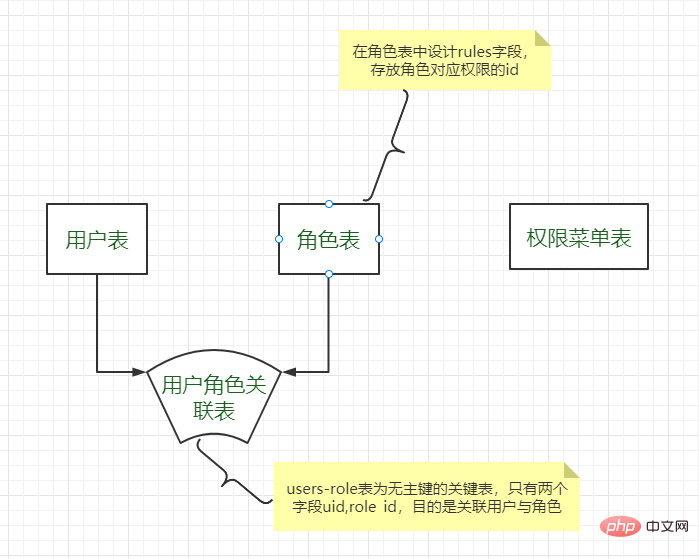
許可權選單表,角色表,使用者表是互相獨立的。設計表的順序是許可權選單表,角色表,使用者表,使用者-角色關聯表。
1. 首先是許可權選單表設計如下:
注意:許可權選單可以是多級選單,新增pid欄位,方便無限極遞迴分類。
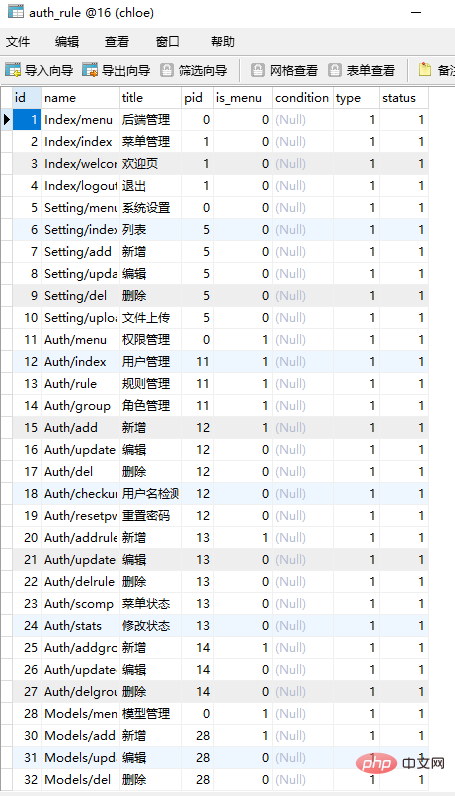
2. 角色表設計如下:
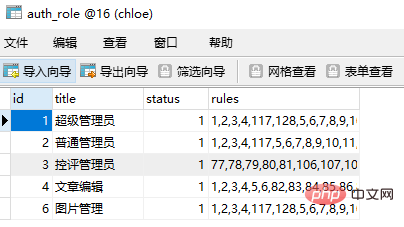
3. 使用者表設計如下:
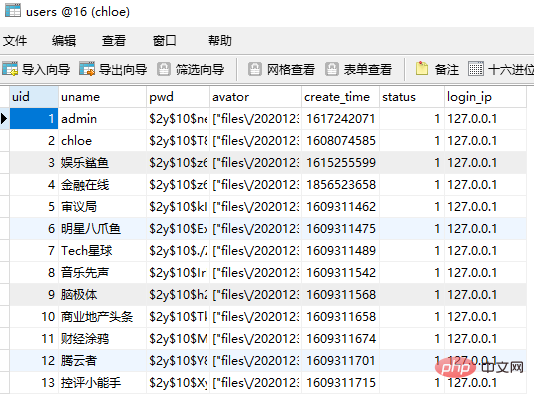
4. 最後是使用者-角色關聯表設計如下:
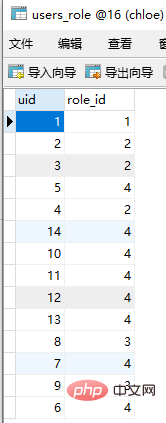
當超級管理員在後臺需要新增新使用者時,不僅需要insert資料進使用者表,也需要在使用者-角色表中新增使用者和角色的關係。與之對應,刪除使用者時,也需要將使用者-角色表中對應的使用者-角色關係刪除。
public function add()
{
if(request()->isPost()){
$role_id = input('post.role_id');
$data = [
'uname'=>input('post.uname'),
'pwd'=>password_hash(input('post.pwd'),PASSWORD_BCRYPT),
'login_ip'=>request()->ip(),
'status'=>input('post.status'),
'create_time'=>time(),
];
$uid = Db::name('users')->insertGetId($data);
if($uid){
$data = [
'uid'=>$uid,
'role_id'=>$role_id
];
$id = Db::name('users_role')->insertGetId($data);
if($id)
{
echo 'true';
exit;
}else{
echo 'false';
exit;
}
}else{
echo 'false';
exit;
}
}else{
//獲取所有角色
$role = Db::name('auth_role')->field('id,title')->order('id','asc')->where('status',1)->select();
return view('add',['role'=>$role]);
}
} 這樣以來我們根據使用者登入以後session中儲存的uid判斷當前登入使用者的身份資訊,根據獲取到的uid查詢使用者-角色關聯表查詢到使用者的角色id, 然後到角色表獲取到該使用者可操作的許可權選單。
封裝中間控制器Common.php
<?php
namespace app\admin\controller;
use app\BaseController;
use think\facade\Session;
use lib\Auth;/**許可權認證類**/
class Common extends BaseController
{
public function initialize(){
$sess_auth = session('uid');
$uname = session('uname');
//判斷使用者是否登入
if(!$sess_auth){
jumpTo('/login/index');
exit;
//檢查到使用者登入後, 還要檢測該使用者是否具有操作某個頁面的許可權, (是否具有操作某個方法的許可權)
}else{
$auth = new Auth();
if(!$auth->check(request()->controller().'/'.request()->action(),$sess_auth)){
historyTo('抱歉~你沒有操作該欄目的許可權,請聯絡管理員!');
exit;
}
}
}
} lib\Auth;/**許可權認證類**/
<?php
use think\facade\Db;
use think\facade\Config;
use think\facade\Session;
use think\facade\Request;
class Auth
{
protected $_config = [
'auth_on' => true, // 認證開關
'auth_type' => 1, // 認證方式,1為實時認證;2為登入認證。
'auth_role' => 'auth_role', // 使用者組資料表名
'users_role' => 'users_role', // 使用者-使用者組關係表
'auth_rule' => 'auth_rule', // 許可權規則表
'auth_user' => 'users', // 使用者資訊表
];
public function __construct()
{
if (Config::get('app.auth')) {
$this->_config = array_merge($this->_config, Config::get('app.auth'));
}
}
/**
* 檢查許可權
* @param string|array $name 需要驗證的規則列表,支援逗號分隔的許可權規則或索引陣列
* @param integer $uid 認證使用者ID
* @param string $relation 如果為 'or' 表示滿足任一條規則即通過驗證;如果為 'and' 則表示需滿足所有規則才能通過驗證
* @param string $mode 執行check的模式
* @param integer $type 規則型別
* @return boolean 通過驗證返回true;失敗返回false
*/
public function check($name, $uid, $relation = 'or', $mode = 'url', $type = 1)
{
if (!$this->_config['auth_on']) {
return true;
}
$authList = $this->getAuthList($uid, $type);
if (is_string($name)) {
$name = strtolower($name);
if (strpos($name, ',') !== false) {
$name = explode(',', $name);
} else {
$name = [$name];
}
}
$list = [];
if ($mode === 'url') {
$REQUEST = unserialize(strtolower(serialize($_REQUEST)));
}
foreach ($authList as $auth) {
$query = preg_replace('/^.+\?/U', '', $auth);
if ($mode === 'url' && $query != $auth) {
parse_str($query, $param); // 解析規則中的param
$intersect = array_intersect_assoc($REQUEST, $param);
$auth = preg_replace('/\?.*$/U', '', $auth);
if (in_array($auth, $name) && $intersect == $param) {
$list[] = $auth;
}
} elseif (in_array($auth, $name)) {
$list[] = $auth;
}
}
if ($relation === 'or' && !empty($list)) {
return true;
}
$diff = array_diff($name, $list);
if ($relation === 'and' && empty($diff)) {
return true;
}
return false;
}
/**
* 根據使用者ID獲取使用者組,返回值為陣列
* @param integer $uid 使用者ID
* @return array 使用者所屬使用者組 ['uid'=>'使用者ID', 'group_id'=>'使用者組ID', 'title'=>'使用者組名', 'rules'=>'使用者組擁有的規則ID,多個用英文,隔開']
*/
public function getGroups($uid)
{
static $groups = [];
if (isset($groups[$uid])) {
return $groups[$uid];
}
$user_groups = Db::name($this->_config['users_role'])
->alias('ur')
->where('ur.uid', $uid)
->where('ar.status', 1)
->join($this->_config['auth_role'].' ar', "ur.role_id = ar.id")
->field('uid,role_id,title,rules')
->select();
$groups[$uid] = $user_groups ?: [];
return $groups[$uid];
}
/**
* 獲得許可權列表
* @param integer $uid 使用者ID
* @param integer $type 規則型別
* @return array 許可權列表
*/
protected function getAuthList($uid, $type)
{
static $_authList = [];
$t = implode(',', (array)$type);
if (isset($_authList[$uid.$t])) {
return $_authList[$uid.$t];
}
if ($this->_config['auth_type'] == 2 && Session::has('_AUTH_LIST_'.$uid.$t)) {
return Session::get('_AUTH_LIST_'.$uid.$t);
}
// 讀取使用者所屬使用者組
$groups = $this->getGroups($uid);
$ids = []; // 儲存使用者所屬使用者組設定的所有許可權規則ID
foreach ($groups as $g) {
$ids = array_merge($ids, explode(',', trim($g['rules'], ',')));
}
$ids = array_unique($ids);
if (empty($ids)) {
$_authList[$uid.$t] = [];
return [];
}
$map = [
['id', 'in', $ids],
['type', '=', $type],
['status', '=', 1]
];
// 讀取使用者組所有許可權規則
$rules = Db::name($this->_config['auth_rule'])->where($map)->field('condition,name')->select();
// 迴圈規則,判斷結果。
$authList = [];
foreach ($rules as $rule) {
if (!empty($rule['condition'])) { // 根據condition進行驗證
$user = $this->getUserInfo($uid); // 獲取使用者資訊,一維陣列
$command = preg_replace('/\{(\w*?)\}/', '$user[\'\\1\']', $rule['condition']);
// dump($command); // debug
@(eval('$condition=('.$command.');'));
if ($condition) {
$authList[] = strtolower($rule['name']);
}
} else {
// 只要存在就記錄
$authList[] = strtolower($rule['name']);
}
}
$_authList[$uid.$t] = $authList;
if ($this->_config['auth_type'] == 2) {
Session::set('_AUTH_LIST_'.$uid.$t, $authList);
}
return array_unique($authList);
}
/**
* 獲得使用者資料,根據自己的情況讀取資料庫
*/
protected function getUserInfo($uid) {
static $user_info = [];
$user = Db::name($this->config['auth_user']);
// 獲取使用者表主鍵
$_pk = is_string($user->getPk()) ? $user->getPk() : 'uid';
if (!isset($user_info[$uid])) {
$user_info[$uid] = $user->where($_pk, $uid)->find();
}
return $user_info[$uid];
}
} 這樣就能實現路由操作許可權的實時檢測,比如我們讓首頁控制器繼承中間控制器:
<?php
namespace app\admin\controller;
use think\Request;
use think\facade\Db;//db類
use think\facade\Session;
use lib\Rule;
class Index extends Common
{
public function index()
{
$uname = session('uname');
$uid = session('uid');
// 根據uid,獲取該使用者相應的許可權,連表查詢
$res = Db::name('users')->alias('u')->where('u.uid',$uid)
->leftJoin('users_role ur','ur.uid = u.uid')
->leftJoin('auth_role ar','ar.id = ur.role_id')
->field('u.uid,u.uname,ar.rules')
->select()->toArray();
// dd($res);
$rules = implode(",",array_column($res,'rules'));
// dd( $rules);
//in查詢 根據獲取到的rules id 選許可權列表
$res = Db::name('auth_rule')->field('id,name,title,pid')->order('id','asc')->where('is_menu',1)
->where('id','in',$rules)->select();
// dump($res);
//這裡使用擴充套件類Rule中封裝的無限極分類方法
$rlist = Rule::Rulelayer($res);
// dd($rlist);
$data = [
'uid'=>$uid,
'uname'=>$uname,
'rlist'=>$rlist,
'create_time'=>1617252175
];
return view('index', $data);
}
}最終實現的效果如圖:
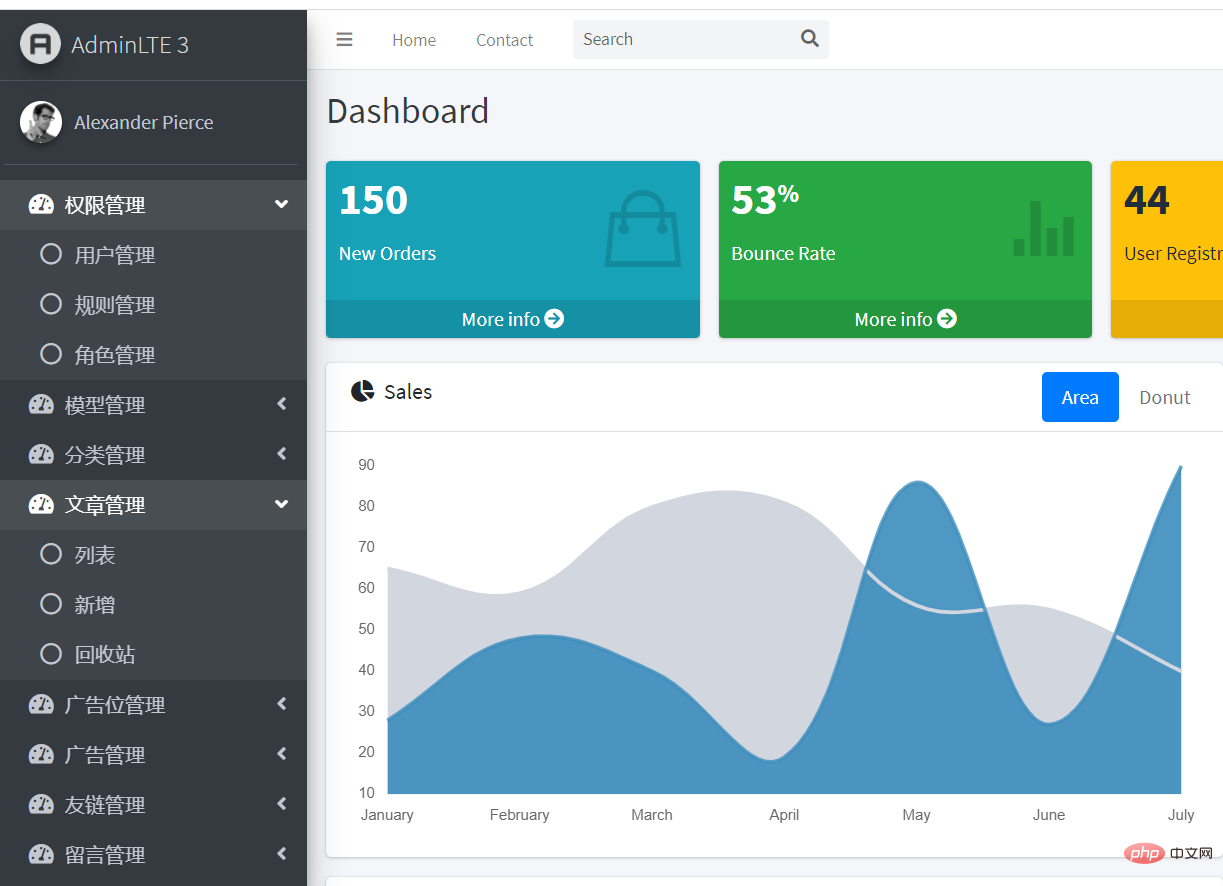
以上就是RBAC許可權控制實現原理——許可權表、使用者表與關聯表設計的詳細內容,更多請關注TW511.COM其它相關文章!